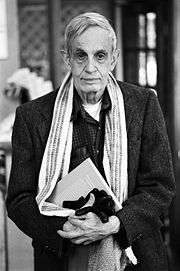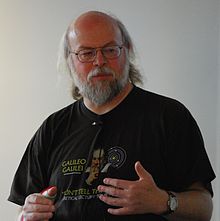Bruce Sterling Woodcock is an American computer and video games industry analyst, best known for his work on subscription tracking of massively multiplayer online games via his website MMOGCHART.COM. Woodcock was born in the small farming community of Sullivan, Missouri on June 20, 1970, the youngest of three children to Myron and Mary Woodcock. He graduated from Sullivan Senior High School in 1988, and then went on to Purdue University, studying physics, philosophy, and computer science. In 1989, he became involved in internet gaming on early MUDs, and in 1990, was briefly running two of the largest TinyMUDs of the time, TinyMUD Classic and Islandia. His original online handle was Sir Bruce Sterling, which was later shortened to Sir Bruce when he began posting on message boards. Leaving college early, he moved to Colorado Springs, Colorado in 1991, where he began a career in information technology. In 1993, he moved to San Jose, California, where he subsequently worked as a system administrator at early ISP Netcom (USA), and then Network Appliance, eventually leaving in 1997 with $250,000 in stock options. He started to maintain a presence on the Yahoo! financial message boards as he closely tracked the performance of Network Appliance, helped the company’s fortunes, and built his own portfolio to $3 million. With the advent of the MMOGs, Chron X and Ultima Online in 1997, Woodcock became a player and beta-tester for this genre of game. He invested in and joined the Board of Directors for Playnet and their game World War II Online, and in August 2002, began his research, reporting, and tracking of MMOG subscription numbers, which has become a standard of reference both inside and outside the MMOG industry. In November 2004 his work was moved to its own dedicated website, MMOGCHART.COM. The site has not been updated since May 2008.
Category: Science Nerd
Lisa Randall (theoretical physicist) was born on June 18, 1962
Lisa Randall is an American theoretical physicist and a leading expert on particle physics and cosmology. She works on several of the competing models of string theory in the quest to explain the fabric of the universe. Her most well known contribution to the field is the Randall-Sundrum model, first published in 1999 with Raman Sundrum. She was the first tenured woman in the Princeton University physics department and the first tenured female theoretical physicist at MIT and Harvard University. Randall was born in Queens in New York City. She is an alumna of Hampshire College Summer Studies in Mathematics and graduated from Stuyvesant High School in 1980, where she was a classmate of fellow physicist and science popularizer Brian Greene. She won first place in the 1980 Westinghouse Science Talent Search at the age of 18. Randall earned a BS from Harvard in 1983, and obtained her Ph.D. in particle physics in 1987 under the direction of Howard Georgi. She was made a fellow of the American Academy of Arts and Sciences in 2004. Randall was featured in Newsweek magazine’s “Who’s Next” issue of January 2, 2006, as “one of the most promising theoretical physicists of her generation.”
John Forbes Nash, Jr. (American mathematician) was born on June 13, 1928
John Forbes Nash, Jr. is an American mathematician whose works in game theory, differential geometry, and partial differential equations have provided insight into the forces that govern chance and events inside complex systems in daily life. His theories are used in market economics, computing, evolutionary biology, artificial intelligence, accounting, politics and military theory. Serving as a Senior Research Mathematician at Princeton University during the latter part of his life, he shared the 1994 Nobel Memorial Prize in Economic Sciences with game theorists Reinhard Selten and John Harsanyi. Nash is the subject of the Hollywood movie A Beautiful Mind. The film, loosely based on the biography of the same name, focuses on Nash’s mathematical genius and struggle with paranoid schizophrenia.
Jacques Cousteau (French explorer, conservationist, filmmaker, innovator, scientist, photographer, author, and researcher) was born on June 11, 1910
Jacques-Yves Cousteau was a French naval officer, explorer, conservationist, filmmaker, innovator, scientist, photographer, author and researcher who studied the sea and all forms of life in water. He co-developed the Aqua-Lung, pioneered marine conservation and was a member of the Académie française. In 1950, he founded the French Oceanographic Campaigns (FOC), and leased a ship called Calypso from Thomas Loel Guinness for a symbolic one franc a year. Cousteau refitted the Calypso as a mobile laboratory for field research and as his principal vessel for diving and filming. He also carried out underwater archaeological excavations in the Mediterranean, in particular at Grand-Congloué (1952). With the publication of his first book in 1953, The Silent World, he correctly predicted the existence of the echolocation abilities of porpoises. He reported that his research vessel, the Élie Monier, was heading to the Straits of Gibraltar and noticed a group of porpoises following them. Cousteau changed course a few degrees off the optimal course to the center of the strait, and the porpoises followed for a few minutes, then diverged toward mid-channel again. It was evident that they knew where the optimal course lay, even if the humans did not. Cousteau concluded that the cetaceans had something like sonar, which was a relatively new feature on submarines.
Francis Crick (English molecular biologist, biophysicist, and neuroscientist) was born on June 8, 1916
Francis Harry Compton Crick was an English molecular biologist, biophysicist, and neuroscientist, and most noted for being a co-discoverer of the structure of the DNA molecule in 1953 together with James D. Watson. He, Watson and Maurice Wilkins were jointly awarded the 1962 Nobel Prize for Physiology or Medicine “for their discoveries concerning the molecular structure of nucleic acids and its significance for information transfer in living material”. Crick was an important theoretical molecular biologist and played a crucial role in research related to revealing the genetic code. He is widely known for use of the term “central dogma” to summarize an idea that genetic information flow in cells is essentially one-way, from DNA to RNA to protein. During the remainder of his career, he held the post of J.W. Kieckhefer Distinguished Research Professor at the Salk Institute for Biological Studies in La Jolla, California. His later research centered on theoretical neurobiology and attempts to advance the scientific study of human consciousness. He remained in this post until his death; “he was editing a manuscript on his death bed, a scientist until the bitter end” according to Christof Koch.
Peter Higgs (British theoretical physicist) was born on May 29, 1929
Peter Ware Higgs is a British theoretical physicist and an emeritus professor at the University of Edinburgh. He is best known for his 1960s proposal of broken symmetry in electroweak theory, explaining the origin of mass of elementary particles in general and of the W and Z bosons in particular. This so-called Higgs mechanism, which had several inventors besides Higgs at about the same time, predicts the existence of a new particle, the Higgs boson (often described as “the most sought-after particle in modern physics”). Although this particle has not turned up in accelerator experiments so far, the Higgs mechanism is generally accepted as an important ingredient in the Standard Model of particle physics, without which particles would have no mass. Prof. Higgs has been honoured with a number of awards in recognition of his work, including the 1997 Dirac Medal and Prize for outstanding contributions to theoretical physics from the Institute of Physics, the 1997 High Energy and Particle Physics Prize by the European Physical Society, the 2004 Wolf Prize in Physics, and the 2010 J. J. Sakurai Prize for Theoretical Particle Physics.
James Gosling (Canadian computer scientist) was born on May 19, 1955
James Arthur Gosling is a Canadian computer scientist, best known as the father of the Java programming language. Gosling is generally credited with having invented the Java programming language in 1994. He created the original design of Java and implemented the language’s original compiler and virtual machine. Gosling traces the origins of the approach to his early 19s graduate-student days, when he created a pseudo-code (p-code) virtual machine for the lab’s DEC VAX computer, so that his professor could run programs written in UCSD Pascal. Pascal compiled into p-code to foster precisely this kind of portability. In the work leading to Java at Sun, he saw that architecture-neutral execution for widely distributed programs could be achieved by implementing a similar philosophy: always program for the same virtual machine.







